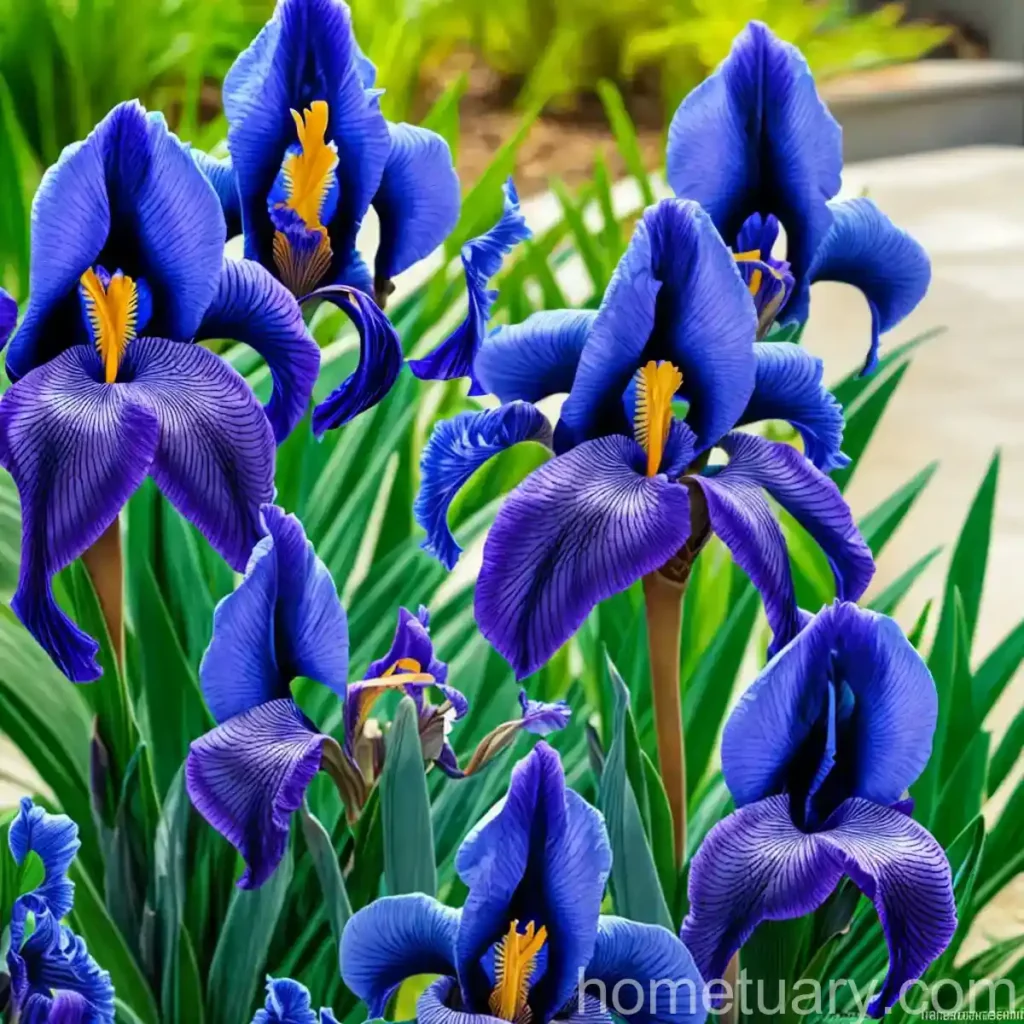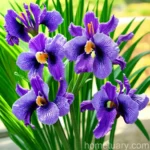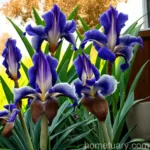Understanding the Southern Blue Flag (Iris virginica var. shrevei)
Plants, in all their diverse forms and functions, play a crucial role in supporting life on earth. From the largest trees to the tiniest algae, each plant species contributes to the vitality and balance of the ecosystems they inhabit. In this article, we explore the Southern Blue Flag (Iris virginica var. shrevei), a captivating and ecologically important plant species.
What is the Southern Blue Flag (Iris virginica var. shrevei)?
Iris virginica var. shrevei, commonly known as the Southern Blue Flag, is a perennial plant species that belongs to the Iris genus and Iridaceae family. It is native to the southeastern United States, where it thrives in wetland habitats such as marshes, pond margins, and shallow waters. This striking plant is known for its vibrant blue to purple flowers and its sword-shaped foliage, making it a favorite in wetland gardens and landscapes.
Key Takeaways – Southern Blue Flag (Iris virginica var. shrevei)
- Plant Name: Iris virginica var. shrevei (Southern Blue Flag)
- Family: Iridaceae
- Genus: Iris
- Habitat: Native to southeastern United States, typically found in wetland habitats
- Characteristics: Vibrant blue to purple flowers, sword-shaped foliage
- Ecological Importance: Provides habitat and food for various wildlife species
- Cultural Significance: Popular choice for wetland gardens and landscaping
- Growing Conditions: Thrives in wet, sunny to partially shaded environments
Now, let’s delve deeper into the various aspects of the Southern Blue Flag, including its culture, uses, and maintenance requirements.
Culture
The culture of a plant encompasses its historical, ecological, and societal significance. Understanding the cultural context of the Southern Blue Flag can provide valuable insights into its role in human history and the natural world.
Uses
The Southern Blue Flag holds several cultural and practical uses, including:
- Garden Ornament: Its vibrant flowers and elegant foliage make it a popular choice for ornamental plantings, particularly in wetland gardens and landscapes.
- Habitat Restoration: Due to its preference for wetland habitats, it is often used in ecological restoration projects to enhance and stabilize wetland ecosystems.
- Wildlife Habitat: The flowers of the Southern Blue Flag attract pollinators such as bees and butterflies, contributing to the overall biodiversity of its native habitats.
Plant Care
Proper care is essential for the healthy growth and development of the Southern Blue Flag. This section outlines key considerations for its care, including water, sunlight, fertilizer, soil, pruning, propagation, and container cultivation.
Water
As a plant that naturally thrives in wetland habitats, the Southern Blue Flag has specific water requirements. It is essential to ensure that the plant receives an adequate water supply, especially during the growing season. However, it is crucial to avoid waterlogging, as excessive moisture can lead to root rot and other issues.
- Watering: Maintain consistently moist soil, especially during periods of active growth and flowering.
- Drainage: Ensure good drainage to prevent waterlogging, especially in container plantings.
Sunlight
Understanding the sunlight needs of the Southern Blue Flag is crucial for its optimal growth and flowering. While it thrives in sunny to partially shaded conditions, the specific sunlight requirements may vary based on regional climate and local environmental factors.
- Sun Exposure: Prefers full sun to partial shade, with a minimum of 6 hours of direct sunlight per day.
- Shade Tolerance: Can tolerate partial shade, particularly in regions with intense afternoon sun or high temperatures.
Fertilizer
Fertilization plays a key role in supporting the growth and blooming of the Southern Blue Flag. By providing essential nutrients, particularly during the active growing season, you can promote healthy foliage and vibrant flowers.
- Fertilizer Type: Use a balanced, slow-release fertilizer formulated for flowering perennials.
- Application: Apply fertilizer in early spring, following the recommended dosage on the product label.
- Avoid Overfertilization: Excessive fertilizer can lead to lush foliage at the expense of flowers, so follow guidelines carefully.
Soil
The type and quality of soil are critical factors in the successful cultivation of the Southern Blue Flag. Understanding the soil preferences of the plant is essential for ensuring healthy growth and longevity.
- Soil Type: Well-draining, rich loamy soil is ideal for the Southern Blue Flag.
- pH Level: Slightly acidic to neutral soil pH (6.0-7.0) is preferred.
- Soil Amendments: Incorporate organic matter such as compost to improve soil structure and fertility.
Pruning
Pruning is an important aspect of maintaining the appearance and vigor of the Southern Blue Flag. Proper pruning practices can also help prevent the plant from becoming overcrowded and enhance its overall aesthetic appeal.
- Deadheading: Remove spent flower heads to encourage continuous blooming and prevent self-seeding.
- Division: Periodically divide crowded clumps to rejuvenate the plant and promote healthy growth.
- Cleanup: Remove any dead or decaying foliage to prevent the spread of diseases and pests.
Propagation
The propagation of the Southern Blue Flag allows for the expansion of its presence in gardens and natural habitats. Understanding the different propagation methods can enable gardeners and conservationists to propagate this species effectively.
- Division: Divide mature clumps in early spring or late summer to create new plants.
- Rhizome Cuttings: Harvest and plant rhizome cuttings to establish new individuals.
- Seed Propagation: While less common, the Southern Blue Flag can be propagated from seeds collected from mature seed pods.
Container Cultivation
For gardeners with limited space or those seeking to create water feature displays, container cultivation offers a viable option for growing the Southern Blue Flag.
- Container Size: Select a spacious container to accommodate the plant’s rhizomatous growth habit.
- Aquatic Containers: For water garden settings, use sturdy, watertight containers to provide the necessary moisture for the plant.
- Maintenance: Monitor soil moisture and ensure that the container has adequate drainage to prevent waterlogging.
Popularity
The Southern Blue Flag’s popularity stems from its captivating flowers, adaptability to wetland environments, and cultural significance. In gardening and landscaping settings, it has gained recognition for its ornamental appeal and ecological value.
- Garden Design: Used in wetland gardens, rain gardens, and naturalistic landscapes to enhance visual interest and attract wildlife.
- Wetland Restoration: Incorporated into wetland restoration and mitigation projects to promote biodiversity and stabilize soil.
Common Diseases
Like all plant species, the Southern Blue Flag is susceptible to certain diseases that can impact its health and vigor. Recognizing and addressing common diseases are essential for maintaining the plant’s vitality.
- Leaf Spot: Fungal pathogens can cause circular lesions on the leaves, leading to aesthetic damage and reduced photosynthetic capacity.
- Root Rot: Prolonged waterlogging or poorly drained soil can predispose the plant to root rot, resulting in wilting and decline.
- Bacterial Soft Rot: Bacterial infections can cause tissue decay and collapse, often leading to the death of affected plant parts.
Disease Diagnosis
When diagnosing and addressing potential diseases affecting the Southern Blue Flag, careful observation and prompt action are essential.
- Symptom Recognition: Evaluate the plant for signs of leaf spots, wilting, discolored foliage, and other abnormal changes.
- Cultural Management: Improve air circulation, reduce overhead watering, and avoid waterlogging to mitigate disease risk.
- Fungicide Treatment: If fungal diseases are identified, apply appropriate fungicides following the manufacturer’s recommendations.
Common Pests
Certain insect pests can pose challenges to the health and appearance of the Southern Blue Flag. Being aware of common pests and their management strategies is crucial for preventing infestations and minimizing damage.
- Aphids: These small, sap-feeding insects can cluster on tender foliage, causing distortion and stunted growth.
- Iris Borers: The larvae of iris borers feed on the plant’s rhizomes and can cause extensive damage if left unchecked.
- Thrips: Thrips are tiny insects that can cause stippling and silvering of foliage, impacting the plant’s aesthetic appeal.
Botanist’s Tips
For those passionate about the cultivation and conservation of the Southern Blue Flag, here are some expert tips to enhance your success with this remarkable plant:
- Habitat Mimicry: When introducing the Southern Blue Flag in gardens, replicate its native wetland habitat by providing consistent moisture and suitable growing conditions.
- Wildlife Support: Embrace the plant’s role in supporting wildlife by creating pollinator-friendly habitats and incorporating it into broader ecological restoration efforts.
- Disease Monitoring: Regularly inspect the plant for signs of diseases and pests, intervening promptly to maintain its health and vigor.
Fun Facts
Uncover intriguing and little-known facts about the Southern Blue Flag that showcase its uniqueness and ecological significance:
- Native Cultures: Historically, Native American tribes used the rhizomes of Iris virginica for medicinal purposes and as a source of starch.
- Pollinator Attraction: The flowers of Iris virginica var. shrevei attract a diverse array of pollinators that contribute to the overall biodiversity of wetland habitats.
- Habitat Restoration: Due to its ecological benefits, the Southern Blue Flag is increasingly utilized in wetland restoration projects and habitat enhancement initiatives.
Links to External Resources
For further exploration of the Southern Blue Flag and related plant topics, consider the following external resources:
- Lady Bird Johnson Wildflower Center: Iris virginica var. shrevei
- USDA Plants Database: Iris virginica var. shrevei
- North Carolina Extension Gardener Plant Toolbox: Iris virginica var. shrevei
- The Iris Society: Southern Blue Flag Irises
In this extensive exploration of the Southern Blue Flag (Iris virginica var. shrevei), we’ve delved into its cultural significance, plant care considerations, ecological roles, and noteworthy attributes. Whether you’re a passionate gardener, a conservationist, or a nature enthusiast, the Southern Blue Flag exemplifies the beauty and resilience of wetland plant species, enriching ecosystems and captivating observers with its vibrant blooms and graceful foliage.















